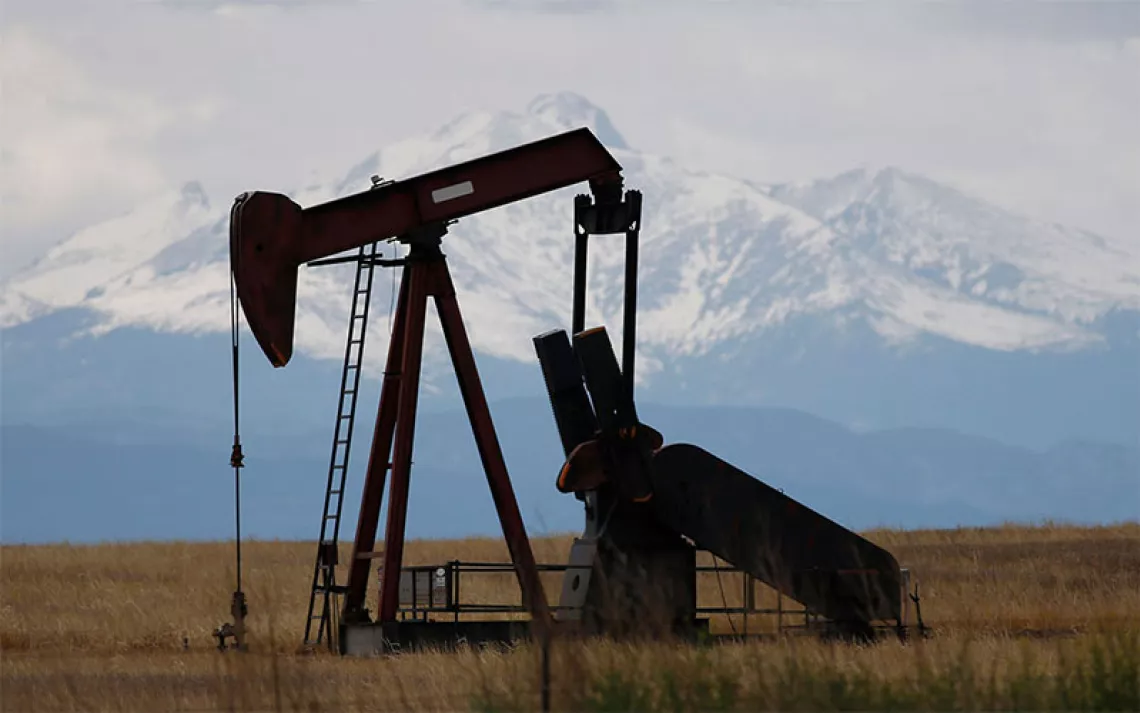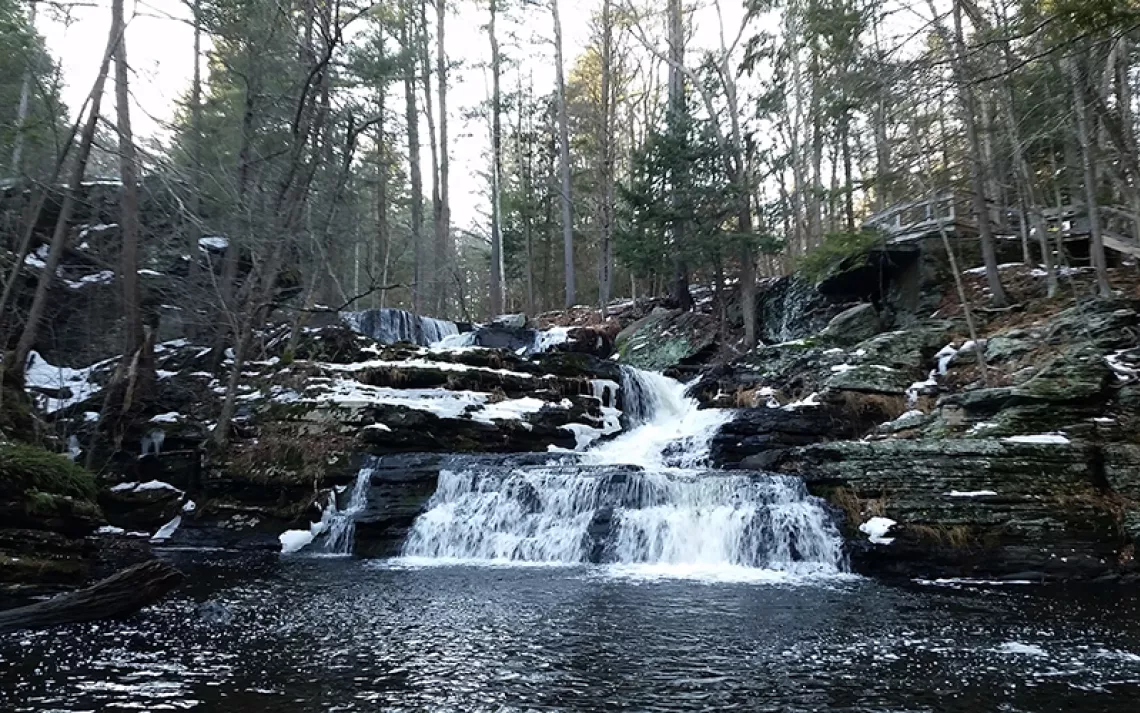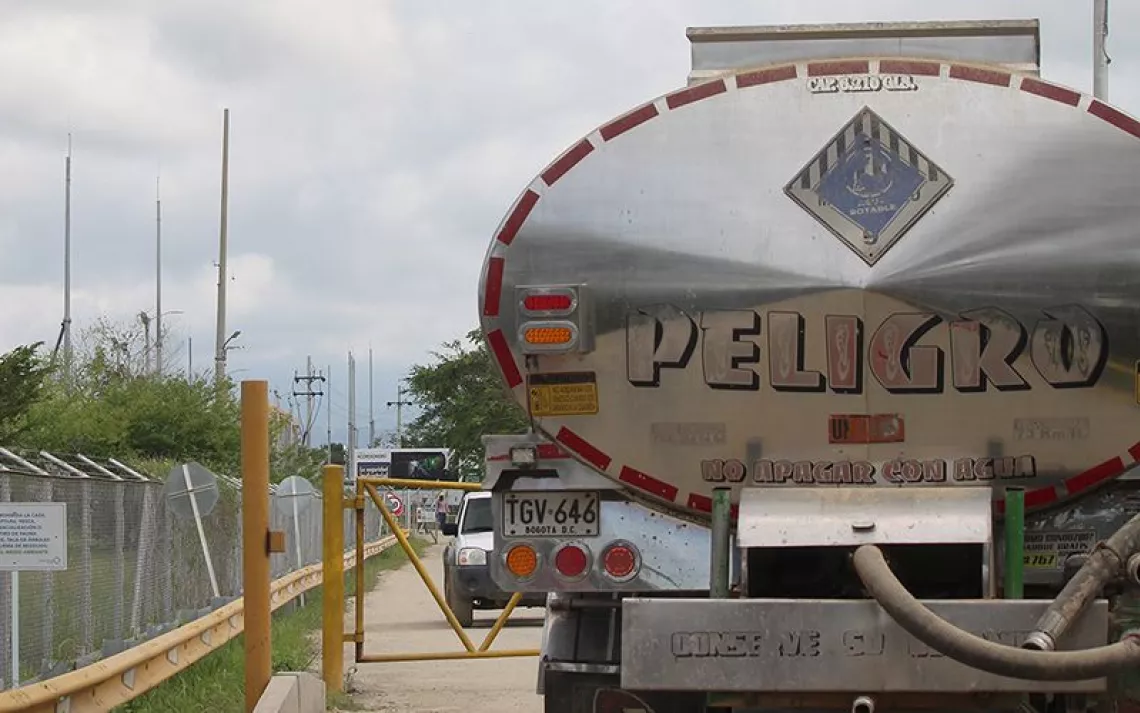Oil and Gas Companies Routinely Frack With “Trade Secret” Chemicals, Including PFAS
A year-long investigation sheds new light on how communities and regulators are kept in the dark
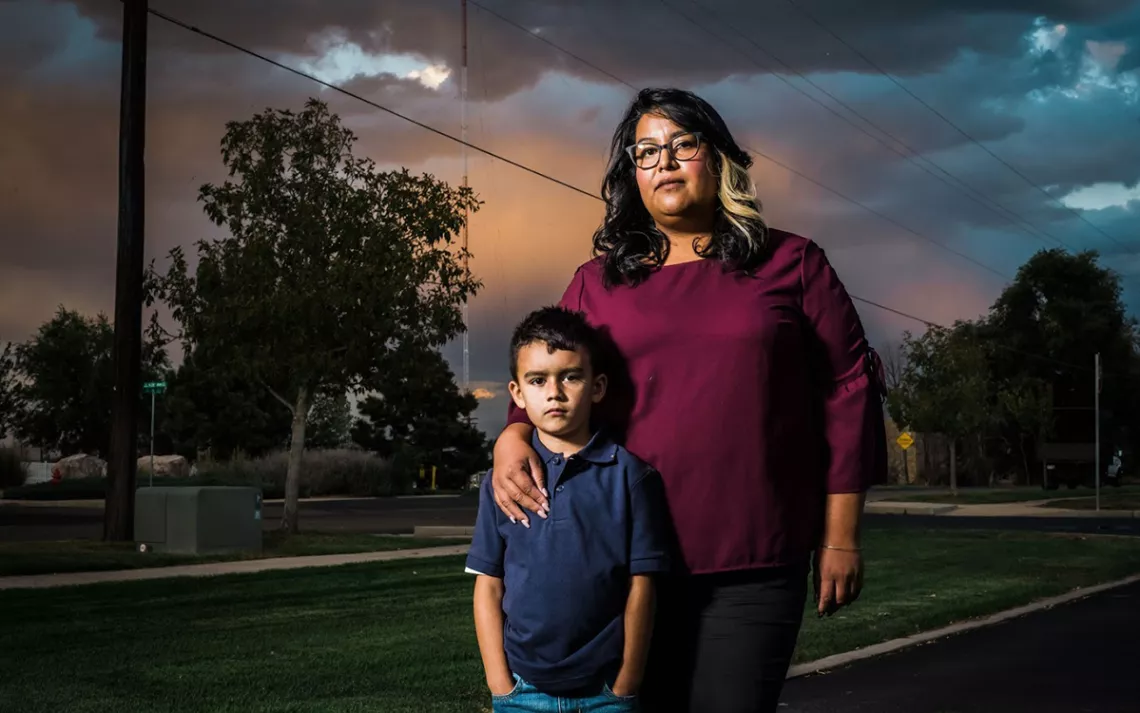
Patricia Nelson and her son in Greeley, Colorado. | Photo by Greg Lowe
Peggy Tibbetts stopped drinking the tap water in her home in Silt, Colorado, 13 years ago. Silt, located in Garfield County, is surrounded by oil and gas wells; in every direction, there is a well pad within just a few miles of Tibbetts’s home. The town gets its water from the Colorado River, downstream from the West Divide Creek tributary, where two well pads blew up in 2004, causing a benzene seep. When Tibbetts’s health began to deteriorate in 2013, she suspected the toxic air emissions from fracking operations were the cause.
“We’ve always known that there are dangerous chemicals being used, but we weren’t allowed to know what they are,” she told Sierra.
Oil and gas companies routinely withhold from regulators and the public the identities of chemicals used in drilling and fracking operations by claiming that the names of those chemicals are a trade secret. Now, a report by Physicians for Social Responsibility (PSR) sheds new light on how residents like Tibbetts are potentially being exposed to dangerous chemicals—including PFAS, proven carcinogens—without their knowledge. The report provides a more precise picture of how much PFAS have been used in the past 10 years in Colorado, though the actual numbers could be much greater.
According to the report, PFAS chemicals were used in at least 10 Colorado counties. In Weld County alone, researchers determined that at least 7,840 pounds of PTFE, also known as Teflon, were used in oil and gas operations there. That number, though, could be a vast undercount of the actual total. In Colorado, well operators are required to disclose chemical use in the fracking process but have the option to shield the precise identity of those chemicals as a “trade secret.” What’s more, operators are not required to disclose the chemicals they use in drilling (the process that precedes fracking). In Weld and Garfield Counties, well operators shielded the identities of chemicals as a “trade secret” in a total of 11,289 wells; a staggering 368 million pounds of unidentified chemicals designated as “trade secret” were used in Weld County alone from 2011 to 2021. In Garfield, 16 million pounds of non-identified chemicals were used.
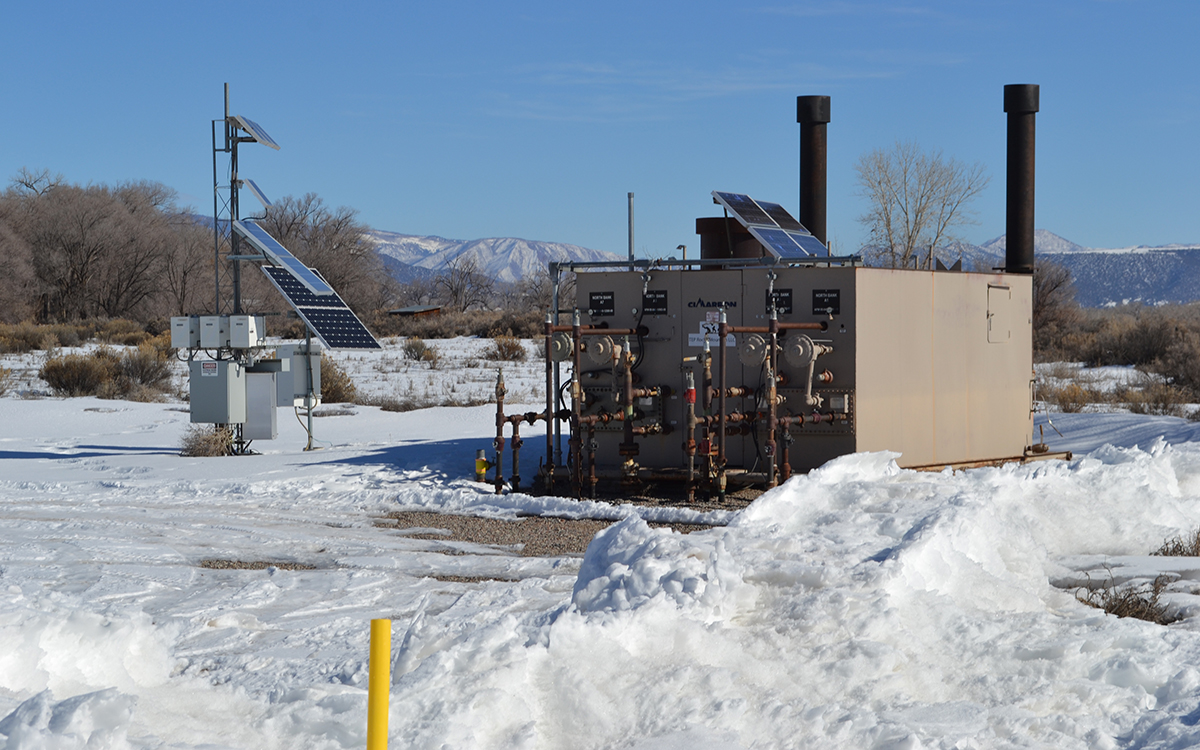
An active well site three miles west of Silt, situated about 1,000 feet from the north bank of the Colorado River, in February. | Photo by Tod Tibbetts
PFAS is a class of what are known as “forever” chemicals because they do not break down in the environment or the human body. And they are as dangerous as they are persistent. Exposure to PFAS chemicals can lead to a wide spectrum of health impacts, including kidney and testicular cancer, as well as childhood leukemia, thyroid disease, high cholesterol, and pre-eclampsia. One measuring cup of PFOA, a class of PFAS used to make industrial and household products such as grease-resistant cookware, would be enough to contaminate 8 billion gallons of water—about as much water as New York City uses in a six-day period. Michigan determined that the maximum allowable level of PFOA in drinking water should be no more than 8 parts per trillion.
Meanwhile in Colorado, according to PSR researchers, nearly 9,000 pounds of PTFE were used in oil and gas drilling and fracking over the past decade, with a total of 414 million pounds of chemicals left unidentified as “trade secret.”
“Laws dealing with the oil and gas industry have been constructed in such a way that companies do not have to fully disclose the chemicals that they are using in drilling and fracking operations to the public, even if those chemicals are extremely toxic and persistent in the environment,” Dusty Horwitt, the lead author of the report, told Sierra. “More than a decade after fracking became a household term and after the oil and gas industry moved significantly into more populated areas, people still don’t know all the chemicals they could be exposed to.”
The system in Colorado and other states for disclosing chemicals used in oil and gas operations is designed specifically to keep communities and regulators in the dark. Well operators are allowed to fill out a simple one-page form if they wish to claim as a “trade secret” the chemicals they are using. In Form 41, they are invited to replace the exact identity of those chemicals with a generic name instead, which can then be used in other disclosures, such as FracFocus—a repository of fracking chemical disclosure for more than 20 states. “You may use a descriptive label such as ‘company TS1’ for a chemical identifier in lieu of identifying the chemical,” the form reads. “This chemical identifier may be used to reference the chemical in subsequent disclosures filed with the chemical disclosure registry.”
“In the very paperwork oil and gas companies have to fill out, they are given the opportunity to shield from the public and from regulators the dangerous chemicals they are using,” Horwitt said.
Gary Allison, an independent data scientist based in Columbus, Ohio, discovered that PTFE had been used in Colorado after searching for it in an open-sourced version of FracFocus called Open-FF that he created. He joined forces with PSR on the Colorado investigation after reading an earlier report from the organization in 2021 about industry use of PFAS in fracking. The research team also discovered a 2008 peer-reviewed industry journal claiming that a type of PFAS called fluorosurfactants had been used in the oil and gas industry for four decades. Because of trade secret laws, exemptions, and other reporting gaps, such use has been hidden from public view. PSR is planning more releases on trade-secret practices in other states.
While millions of pounds of potentially dangerous chemicals are being used in drilling and fracking operations throughout Colorado, there appears to be no effort from regulators or elected officials to require greater transparency from the industry. Nor is there any testing regime robust enough to determine how the usage of these chemicals is impacting the environment or public health. Asked to account for this, a community relations supervisor for the Colorado Oil and Gas Conservation Commission (COGCC) said in a written statement that the COGCC would only require a well operator to test for PFAS if the COGCC “has a reason to believe there may be PFAS in a spill or release of E&P waste (exploration and production waste), over which COGCC has jurisdiction.” The statement did not address the fact that chemicals are routinely pumped into the ground during drilling and fracking operations, spill or no spill.
EPA studies have found confirming evidence that fracking fluids contaminate drinking water. When asked for comment, a spokesperson for EPA Region 8, which includes Colorado, said in a written statement, “The EPA Underground Injection Control Program detailed requirements for well construction and integrity, monitoring, and reporting to ensure that the specific injected fluid does not endanger underground sources of drinking water. Permits are issued for each individual injection activity, and EPA does not track this nationally.”
Some Colorado residents feel betrayed by a system they say is specifically designed to curry favor with the fossil fuel industry and protect its profits while they are left to bear the consequences. “The fossil fuel industry owns the world, and we just live in it,” Tibbetts said.
Tibbetts considered moving out of Silt when she became seriously and chronically ill. In 2013, her immune system broke down. After undergoing blood and urine tests, she learned her body had become contaminated with BTEX—shorthand for benzene, toluene, ethylbenzene, and xylene. She decided to stay in Silt after drilling operations started phasing out there in 2014 and the air quality improved. Her health improved along with it. She blames the oil and gas industry for her illness, and regulators and local officials for doing nothing about it.
“They’ve contaminated our environment. They’ve contaminated the groundwater and the soil,” she said. “The fact that nothing has been done shows that they don’t listen and they don’t care.”
In the Weld County town of Greeley, Shirley Smithson has been fighting the oil and gas industry for years. She is a local leader with the Sierra Club and a member of Weld Air & Water, both of which tried to block a 24-head directional well pad from being sited within 1,200 feet of the Bella Romero Academy middle school, which is mostly attended by children from working-class, immigrant, and minority families. The well, which is just 600 feet from the school’s playing field, has been operational since 2019. In 2020, an independent report found that air quality readings near the school breached health standards for benzene exposure 113 times during the monitoring period.
Smithson said while there was one community meeting held for the public before the Bella Romero permit was issued, residents’ voices were ignored. As far as she knows, nothing is being done now to test for hazardous emissions or for PFAS chemicals being used in these operations.
“That’s just wrong,” she said. “It’s not safe for those kids who are running around in a playing field with whatever is coming out of those well pads: methane, benzene, who knows what.”
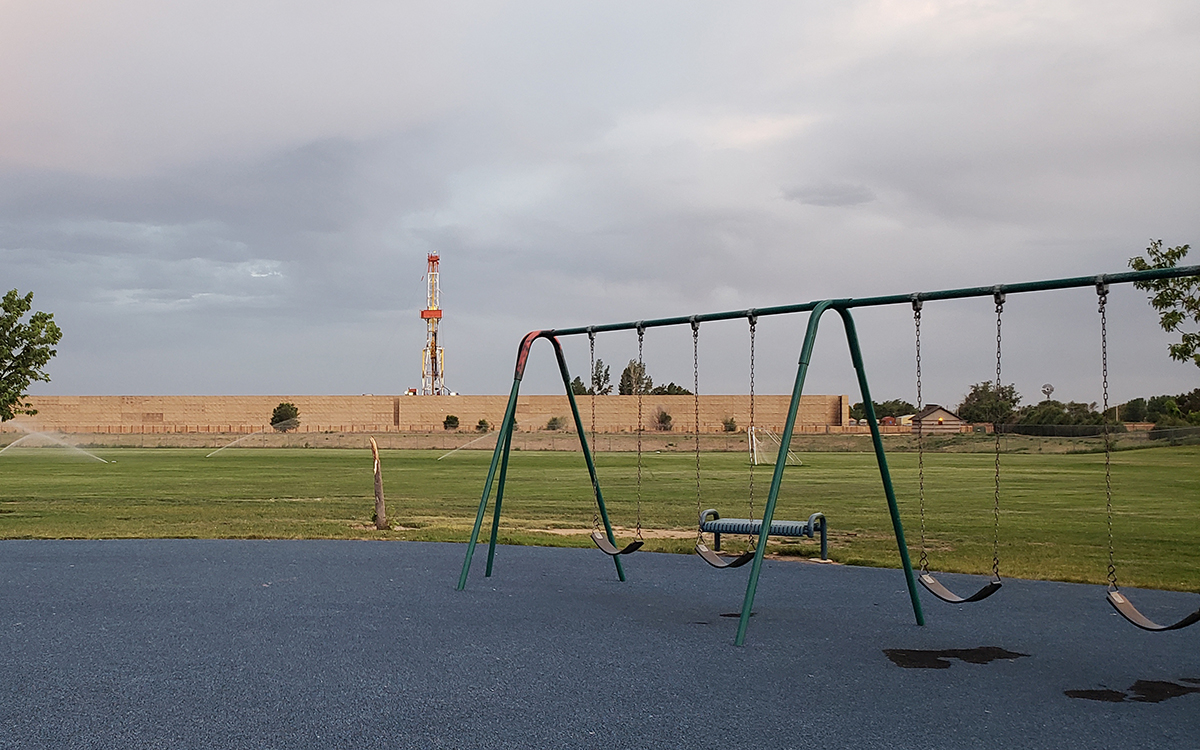
A fracking well pad is visible in the distance, sited just 600 feet from the playfield at the Bella Romero Academy middle school. | Photo courtesy of Patricia Nelson
Patricia Nelson had just moved to Greeley from Lake Charles, Louisiana, in 2016 to escape the abundance of petrochemical plants there when she learned about the proposed well pad near Bella Romero. She had relocated her family to Colorado because she wanted her son to experience the state she had grown up in. “When I grew up here,” she said, “we didn’t have fracking in our backyards. That’s what I thought I was bringing my son home to.”
Nelson filed a complaint against the COGCC for the approval of the Bella Romero permit. Eventually, she moved to another part of the city of Greeley so that her son would not have to attend school there.
“That was what I felt I had to do to protect my son,” she said. “But my sister’s kids still go there; my cousin’s kids still go there; our godparents’ children go there. And I’m being told that my nieces are waking up in the middle of the night with bloody noses, and my nephew is constantly having all of these rashes that no one can treat or diagnose. If that’s happening to my immediate family, what’s happening to all the other families that are also being impacted? And nothing has changed. There are still wells at Bella Romero.”
Leading the list of the companies that fracked the most wells in Colorado, according to the PSR report, are Anadarko Petroleum Corporation—which has used over 4 million pounds of a surfactant, the identity of which it has withheld as a trade secret—and Noble Energy, which has used almost 2 million pounds of non-identified chemicals.
“In many industries, the laws are written first to benefit those industries and then we as citizens and activists and health professionals and other concerned people need to push back and say no, the interests of industry are not paramount,” Barb Gottlieb, director of environment and health at Physicians for Social Responsibility, said. “The interests of people need to come first. Health protection needs to come first.”
PSR is calling for the reform of disclosure laws to force well operators to reveal the identities of the chemicals they use, and for Colorado regulators and the EPA to prohibit PFAS from being used in fracking or from being manufactured or imported into the state for oil and gas extraction.
“As someone who lives here, you get this feeling that you’re helpless—that there’s nothing you can do about this,” Shirley Smithson said. “And, that you’re stuck, because your home, your environment, your whole sense of safety and security has been threatened and there’s nobody listening. What happens over time is that you just say to yourself, 'Well, I guess I have to move'— but that is really hard because it’s so expensive to move elsewhere, and a lot of people have nowhere else to go. So, you decide you just have to learn to live with it because there is no way out.”
 The Magazine of The Sierra Club
The Magazine of The Sierra Club
